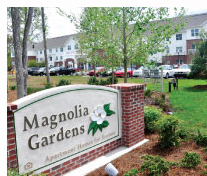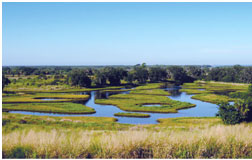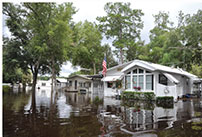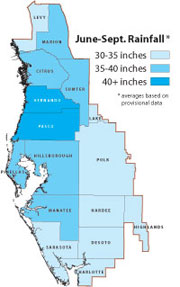
District staff celebrated many accomplishments in 2012 and continued to serve the community by carrying out the core mission.
After decades of collaboration and work with other cities, agencies and community partners, several restoration projects were completed in 2012. Projects like those at Cockroach Bay and Clam Bayou improved water quality and restored sensitive habitats.
Mother Nature packed a wallop in 2012, bringing the threat of two tropical storms. Staff worked around the clock to serve the needs of the community. The rainy season delivered positive results for the area. The above-normal rainfall brought improvement to water resources not seen in more than seven years in the District’s region.
The District continued to find new ways to work efficiently and save money. That included moving District records from an off-site facility to a building at the Brooksville Headquarters, which meant a minimum savings of $200,000 a year. Also, the District recently restructured the Regulation Division to increase consistency.
Water StarSM Shines

The Florida Water StarSM program saw a lot of firsts in 2012. In January, Fred Hartless became the first District employee to get his home certified under the Florida Water StarSMprogram.
The geographic information system (GIS) analyst in the Data Collection Bureau decided to bring the District’s mission of water conservation into his own home.
“I decided to walk the walk,” Hartless said. “Water went up again and is really expensive in Pasco, so I thought this would be something good to do to save money for my family.”
Florida Water StarSM is a voluntary certification program for builders, developers and homeowners. The program encourages water efficiency in appliances, plumbing fixtures, irrigation systems and landscapes.
Later in the year, a Brooksville apartment complex became the first in the state to be certified under the Florida Water StarSM Community standard. A second complex in Port Richey became the first in Pasco County to be certified under the Florida Water StarSM Community standard.
Cockroach Bay Completed

The District celebrated the completion of a 20-year restoration project at Cockroach Bay in April. It was one of the largest, most complex coastal ecosystem restoration projects ever developed for Tampa Bay.
“This project is a magnificent achievement for the Tampa Bay region,” Executive Director Blake Guillory said at the dedication ceremony. “It’s recognized internationally as the way to do habitat restoration. Its success is due to 20 years of hard work and collaboration between many team members.”
Before the restoration, Cockroach Bay suffered from a number of environmental problems including habitat degradation, invasive plant infestation and poor water quality.
The restoration was completed in 17 phases through the past 20 years as a pay-as-you go project. In 1991, Hillsborough County purchased the 651-acre property located just outside the Alafia River watershed boundary in southwest Hillsborough County. The land was largely agricultural fields and shell mining pits near the bay.
The project was initiated by the District’s Surface Water Improvement and Management (SWIM) Program and the Hillsborough County Parks, Recreation and Conservation Department. It took the help of 26 groups and government agencies, plus the collaboration of many teams within the District.
As part of the restoration project, garbage was removed while other recycled materials were brought in. About 176 tons of garbage were hauled away from the 500-acre restoration site during the course of the project. And 500,000 cubic yards of recycled dredged material were used to restore a portion of the mining pits. The final phase of the project included restoring two shell pits funded by the Tampa Port Authority.
Tropical Storms Keep Staff on Alert

Two tropical storms kept staff busy during this past hurricane season. Tropical Storm Debby brought record rainfall, flooding and damage to various areas of the District in June.
As part of the District’s core mission of flood protection, staff immediately responded to the needs of the community in a variety of ways.
The District’s water control structures were monitored around the clock by Structure Operations staff, opening gates in areas where relief was needed. Some areas in Pinellas, Pasco, Hernando and Citrus counties experienced flooding during a 24-hour period that likely only occurs every 50 to 200 years.
The District offered assistance in other ways such as providing a sandbagging unit and 1,000 sandbags to Hernando County Public Works. Staff also repaired sinkholes in the Masaryktown Canal and several other canals and structures that saw erosion from flood waters.
Operations and Land Management also sent staff to Live Oak to help the Suwanee River Water Management District (SRWMD) with flooding. Staff assisted SRWMD with pumping out flood waters that surrounded SRWMD offices and a public health building in Live Oak.
Two months later, Tropical Storm Isaac would cause the District to activate its Emergency Operations Center again. Luckily, the storm’s path had a minimal effect on the District.
Document Relocation Brings Big Savings

The District began relocating its records in 2012 in an effort to save money. Staff started moving records out of an off-site storage facility managed by a third-party and into Building 3 at the Brooksville Headquarters. The switch will save the District a minimum of $200,000 a year.
But making that switch has been a complex process.
First, the building had to be prepped. Land Resources was relocated out of the building and the facility was completely cleared. Shelving was installed and the aging sprinkler system was replaced. The building windows were covered with hurricane shutters to ensure protection of the documents. Also, security for the building was increased.
The record boxes are each marked with a bar code. They are scanned and assigned a place in the storage facility. That information is tracked so the boxes can be easily found if they need to be accessed.
Earl Rich, Document Services manager, said his staff pull about 3,000 boxes a year, plus add about 2,000 boxes. In fact, when the transition is complete, more than a million pounds of paper will be housed in the facility.
District Welcomes New Faces to the Governing Board

The year brought a couple of new appointments to the Governing Board. Wendy Griffin was appointed in September and is a retired environmental consultant. She was named to succeed Hugh M. Gramling, and her term ends March 1, 2016.
Griffin began her 30-year environmental career in 1976 as an environmental specialist for the Hillsborough County Environmental Protection Commission. In 1979, she became the Environmental Administrator for the Florida Department of Transportation’s 14-county District I.
Griffin entered the private sector in 1985 as a Project Manager, where she assisted clients with environmental assessments and permitting for roadways, commercial and residential developments, airports, phosphate mines and gas pipeline projects. In 1996, Griffin founded her own company, Metis Environmental Services, Inc., where she specialized in permitting, mitigation and assessing potential impacts for proposed phosphate mine expansions in central Florida. Ms. Griffin is presently retired.
George Mann was appointed in November and is a retired business development manager at Treatt USA, which processes citrus products. Mann was appointed to succeed Neil Combee, and his term ends March 1, 2013.
Mann spent much of his career in the citrus industry managing many categories, including juice sales and citrus related by-products such as oils, aromas and essences. At Treatt USA, his focus was on natural flavor ingredients for the beverage industry, many of which were derived from citrus products.
Mann is currently serving as a board member of Anchor House Ministry. Previously, he served on the Florida Citrus Processors Association Committee and the Editorial Advisory Board of the Citrus & Vegetable Magazine. Mann received a bachelor’s degree in Citrus Business from Florida Southern College in Lakeland.
Rainy Season Improves Water Resources

Above-normal rainfall during the summer rainy season brought significant improvement to water resources not seen in more than seven years in the District’s region.
Many of the District’s lakes, rivers and aquifers recovered after a four-year drought which started in 2005. Rainfall totals from the four-month rainy season show above normal averages across the District.
“This summer was a drought breaker for us,” said Granville Kinsman, the District’s hydrologic data manager. “Areas north of the Tampa Bay area especially saw major improvements.”
Some lakes in the northern region rose more than four feet. Also, the Withlacoochee River is back in the normal range for flows.
Despite the record rains, the District experienced a dry winter. Staff has been closely monitoring conditions to determine if tighter water restrictions are needed.
District Dedicates Clam Bayou
The District celebrated the completion of the Clam Bayou Restoration and Stormwater Project in October. The completion of the project marks the final step in a multi-agency effort to restore 64 acres of estuarine and coastal habitats and create 20 acres of ponds to treat stormwater runoff from the 2,600-acre area.
“This project exemplifies a lot of great work done through cooperative partnerships,” said District Governing Board member Todd Pressman.
Clam Bayou is a 170-acre preserve in Pinellas County. It is surrounded by the cities of Gulfport and St. Petersburg to the north, east and west, and Boca Ciega Bay to the south. About 127 acres of Clam Bayou are publicly owned.

Since the 1920s, urban development around the bayou drastically altered the natural habitats and hydrology of the system. In addition, the bayou’s surrounding areas were developed prior to stormwater regulations, which resulted in large amounts of trash, sediments and pollutants flowing untreated into Clam Bayou and ultimately into Boca Ciega Bay and Tampa Bay.
In 1995, the District and its partners acquired land and started construction projects to restore native habitats and treat stormwater. The project was funded in three phases during the past 17 years as a pay-as-you-go project. The District contributed more than $7 million during the three phases. That includes nearly $900,000 the District secured through a grant from the U.S. Environmental Protection Agency.
The project was managed by Brandt Henningsen and Janie Hagberg from the District’s Surface Water Improvement and Management (SWIM) Program. With the completion of the Clam Bayou projects, trash, sediments and pollutants entering the estuary have been reduced. Nonnative plant species, such as Brazilian pepper, Australian pine trees and Guinea grass, have been removed and the public lands have been restored to a more natural state.
Organizational Changes Create Efficiencies

The District continued restructuring to improve efficiencies.
The Project Management Office (PMO) was created in December to make procedures more consistent and efficient. It was created with the purpose of providing support to the cooperative funding process and other District initiatives. By reviewing and refining the current procedures, the PMO will find ways to improve the process, said James Fine, the new office chief of the PMO.
“Our goal is to work with the different bureaus in the Resource Management Division that handle cooperative funding projects to develop a consistent system,” he said.
Earlier in the year, the District restructured the Regulation Division. The restructuring aimed to eliminate duplication, increase efficiency, increase consistency and reduce costs. The division was able to accomplish those goals by:
- Centralizing the permitting review process to the Tampa Service Office to ensure that permit applications throughout the District are evaluated consistently.
- Consolidating staff and programs in a central location to increase efficiencies, eliminate duplication of services and reduce costs.
- Maintaining a local presence in service offices to ensure quality customer service to the public.
- Enhancing and improving online permitting to make it easier and more convenient to submit a permit application and access permit data.
